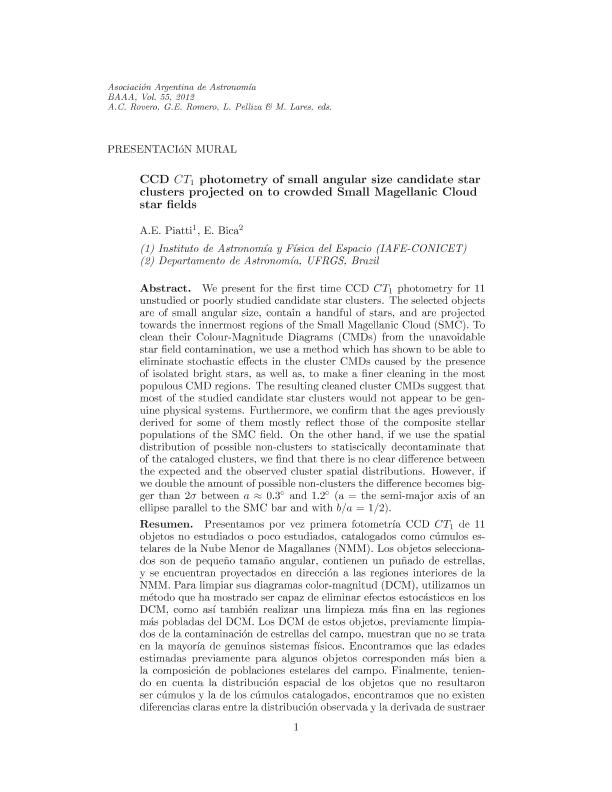Artículo
We present for the first time CCD CT1 photometry for 11 unstudied or poorly studied candidate star clusters. The selected objects are of small angular size, contain a handful of stars, and are projected towards the innermost regions of the Small Magellanic Cloud (SMC). To clean their Colour-Magnitude Diagrams (CMDs) from the unavoidable star field contamination, we use a method which has shown to be able to eliminate stochastic effects in the cluster CMDs caused by the presence
of isolated bright stars, as well as, to make a finer cleaning in the most populous CMD regions. The resulting cleaned cluster CMDs suggest that most of the studied candidate star clusters would not appear to be genuine physical systems. Furthermore, we confirm that the ages previously derived for some of them mostly reflect those of the composite stellar populations of the SMC field. On the other hand, if we use the spatial distribution of possible non-clusters to statiscically decontaminate that of the cataloged clusters, we find that there is no clear difference between the expected and the observed cluster spatial distributions. However, if we double the amount of possible non-clusters the difference becomes bigger than 2σ between a ≈ 0.3◦ and 1.2◦ (a = the semi-major axis of an ellipse parallel to the SMC bar and with b/a = 1/2). Presentamos por vez primera fotometría CCD CT1 de 11 objetos no estudiados o poco estudiados, catalogados como cúmulos estelares de la Nube Menor de Magallanes (NMM). Los objetos seleccionados son de pequeño tamaño angular, contienen un puñado de estrellas, y se encuentran proyectados en dirección a las regiones interiores de la NMM. Para limpiar sus diagramas color-magnitud (DCM), utilizamos un método que ha mostrado ser capaz de eliminar efectos estocásticos en los DCM, como así también realizar una limpieza más fina en las regiones más pobladas del DCM. Los DCM de estos objetos, previamente limpiados de la contaminación de estrellas del campo, muestran que no se trata en la mayoría de genuinos sistemas físicos. Encontramos que las edades estimadas previamente para algunos objetos corresponden más bien a la composición de poblaciones estelares del campo. Finalmente, teniendo en cuenta la distribución espacial de los objetos que no resultaron ser cúmulos y la de los cúmulos catalogados, encontramos que no existen diferencias claras entre la distribución observada y la derivada de sustraer los objetos que no son cúmulos. Sin embargo, si duplicamos la cantidad de objetos que posiblemente no son cúmulos, la diferencia resulta mayor que 2σ entre a ≈ 0.3◦ and 1.2◦ (a= semi eje mayor de una elipse paralela a la barra de la NMM y con b/a=1/2)
CCD CT1 photometry of small angular size candidate star clusters projected on to crowded Small Magellanic Cloud star fields
Fecha de publicación:
06/2012
Editorial:
Asociación Argentina de Astronomía
Revista:
Boletín de la Asociación Argentina de Astronomía
ISSN:
0571-3285
Idioma:
Inglés
Tipo de recurso:
Artículo publicado
Clasificación temática:
Resumen
Palabras clave:
Cluster
Archivos asociados
Licencia
Identificadores
Colecciones
Articulos(IAFE)
Articulos de INST.DE ASTRONOMIA Y FISICA DEL ESPACIO(I)
Articulos de INST.DE ASTRONOMIA Y FISICA DEL ESPACIO(I)
Citación
Piatti, Andres Eduardo; Bica, E.; CCD CT1 photometry of small angular size candidate star clusters projected on to crowded Small Magellanic Cloud star fields; Asociación Argentina de Astronomía; Boletín de la Asociación Argentina de Astronomía; 55; 6-2012; 143-146
Compartir




